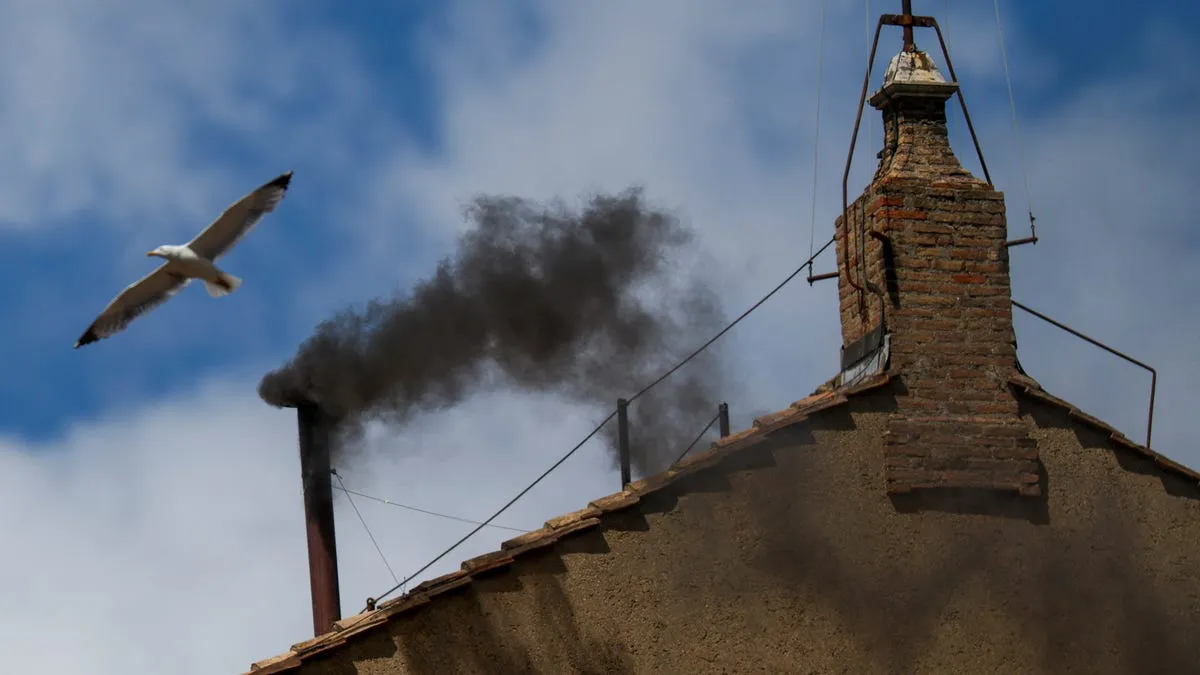
On Thursday, black smoke billowed from the chimney of the Sistine Chapel in Rome, indicating that the 133 cardinals locked inside had yet to reach a decision on a successor to Pope Francis. This marked the beginning of the second day of the conclave, a secretive process that will ultimately decide the leadership for the world’s 1.4 billion Roman Catholics.
The day commenced with a solemn Mass held in the Pauline Chapel, followed by a mid-morning prayer session within the Sistine Chapel. The cardinals were cut off from the outside world as they participated in the crucial voting process to determine the next pope. On Thursday morning, two rounds of voting were permitted, after which a lengthy lunch break followed. The cardinals would then reconvene for two additional votes. If a new pope was not elected by approximately 7:30 p.m. local time (1:30 p.m. ET), they would conclude their activities for the day.
There are over 250 cardinals in the Roman Catholic Church, but only those under the age of 80 are eligible to vote in the conclave. Cardinal Giovanni Battista Re, the dean of the College of Cardinals, is 91 years old and thus not part of the voting process. While he was in Pompeii on Thursday, he expressed optimism about the conclave’s outcome, hoping to see white smoke signaling a new pope upon his return to Rome. He emphasized that the elected pope must focus on strengthening faith in God, especially in a world increasingly characterized by technological advancements.
Tens of thousands of tourists, pilgrims, and curious onlookers gathered in St. Peter's Square on Wednesday, eagerly awaiting the emergence of white smoke, which would indicate the selection of a new pope. However, the smoke was black, denoting that the cardinals had not reached a decisive vote. The crowd returned on Thursday morning, lining up under the sun to witness the ongoing conclave, which had entered its second day after the initial vote on Wednesday failed to yield a successor to Pope Francis.
The tradition of using smoke signals during the conclave is deeply rooted in history: black smoke indicates that no candidate has secured the necessary votes, while white smoke signifies the election of a new pope. The ban on communication with the outside world, a practice dating back to medieval times, remains in effect. To uphold the secrecy of the conclave, the Vatican has implemented modern technology measures, including the prohibition of cellphones and the use of jamming devices to prevent any recording devices from being present.
As the conclave unfolds, several cardinals are frequently mentioned as potential successors to Pope Francis. Among the notable candidates are non-Italians such as Luis Antonio Tagle from the Philippines, often referred to as "Francis 2," and France’s Jean-Marc Aveline, Archbishop of Marseille. Cardinal Peter Erdo of Hungary is also considered a favorite among more conservative cardinals. Additionally, strong Italian contenders like Cardinal Pietro Parolin, the Vatican Secretary of State, and Cardinal Matteo Zuppi, a close associate of Francis, add to the competitive landscape.
This conclave is notable for its record participation, with 133 cardinals from 70 countries casting votes, a significant increase from the 115 cardinals from 48 nations who participated in the 2013 conclave that elected Pope Francis. This growth reflects Francis' efforts to broaden the Church's global reach, with 80% of current cardinals appointed by him.
The conclave allows for up to four rounds of voting each day, although there is no strict time frame for its duration. Recent conclaves have typically concluded within a few days; since 1846, the average duration for the election of the past 12 popes has been between two to five days. However, history shows that conclaves can extend for much longer—after the death of Pope Clement IV in 1268, cardinals took nearly three years to elect a new pope.
The ongoing discussions within the conclave reflect a shifting geographic balance in Catholicism, increasingly centered in the global south. As of 2023, Africa accounts for 20% of the worldwide Catholic population, a dynamic growth that the Vatican recognizes as vital for the future of the church. Cardinal candidates from Africa, such as Cardinal Peter Turkson of Ghana and Cardinal Robert Sarah of Guinea, exemplify this emerging influence.
As the conclave progresses, the world watches closely, awaiting the moment when white smoke will finally emerge from the Sistine Chapel chimney, signaling the election of a new leader for the Catholic Church.